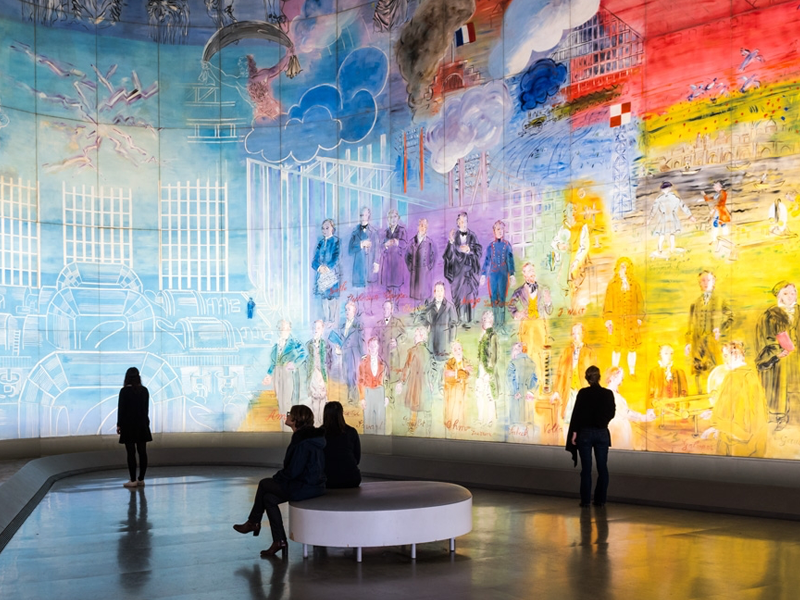
5 digital experiments that explore the future of the cultural heritage sector
Of course, technology is just a delivery method, but it’s a medium with huge creative potential; pushing the boundaries of how stories are told, and how audiences can engage with them. There is no shortage of these digital experiments in the heritage sector, so here are a few that have excited us recently.
THE SMITHSONIAN VR EXPERIMENT
The Smithsonian Art Museum in Washington D.C. has one of the most enviable collections of American art in the U.S., exhibiting early colonial pieces alongside masterpieces from the Gilded Age, American impressionism and, increasingly, more contemporary work from the 21st century.
This embrace of the new filters through into its ethos for tech experimentation, as well. The museum was one of the first of its kind to launch a website back in 1995, and through its Artful Connectionsinitiative, they offer schools the chance to explore U.S. history and culture through free interactive videoconferences. Its entire collection is also digitised, democratising the collection for people across the world to enjoy.
This year, the museum teamed up with Intel to experiment with VR – offering virtual reality tours of one of its wings. Using a combination of laser scanning and photogrammetry – i.e. creating 3D models from 2D photographs – the team was able to reconstruct part of the building for VR exploration.
So, you can walk around some of the exhibits in virtual reality. Interesting, but not much more experimental than other VR experiences. However, the creators have decided to have a bit more fun with the project. Three of the pieces on show allow users to ‘step inside’ the art work. Walk through Frederic Edwin Church’s painting of the Aurora Borealis, for instance, and you’re transported to an Icelandic landscape, confronted by a breathtaking 360 degree video of the real Northern Lights.
The bronze Adams Memorial sculpture by Augustus Saint-Gaudens, meanwhile, doubles as a gateway to the tranquil calm of the real Adams Memorial in Washington, D.C. – the visitor suddenly surrounded by trees and birds. This is storytelling with a difference – using technology to physically transport someone into a totally different space, mood, feel and world, without them leaving the museum, or even from the comfort of their own home.
VR is still in its infancy in the heritage sector, but its immersive power will undoubtedly play a role in future experiences in weird, wonderful and exciting ways.
TECH FORGERY OF A GRAND MASTER
What makes a great artist? While it’s impossible to quantify, the true masters had, and have, their own indelible style – easy to identify, impossible to emulate. Almost.
In 2016, the advertising agency J Walter Thompson and their client, Dutch-born international bank, ING, commissioned a new piece of work from one of Holland’s most prolific and celebrated artists – Rembrandt. The problem was, Rembrandt died in 1669. The agency brought together a team of researchers and technologists from Microsoft, Delft University of Technology and a couple of Dutch galleries to analyse previous works of the Dutch master using artificial intelligence.
They looked at brush strokes; colour; texture; light; shade; character; and developed an algorithm to learn and perfectly mimic his style. The result was ‘The Next Rembrandt’, a remarkable new work from a long dead maestro.
The project sparked debate and controversy in the art world, and beyond – can computers truly be artists? Is it sacrilege? But this combination of digital experimentation and creative arts reveals exciting new potential for customer engagement. Imagine visitors being able to watch new masterpieces created live, or watching how artists may have worked, even commissioning their own work.
Once ‘The Next Rembrandt’ was finished, the team 3D printed the result – giving tangible, physical life to a digital experiment. And though this project was a commercial venture, it’s one which asks questions and starts conversation about tech innovation and its role in the heritage sector.
THE LIVING EXHIBIT
You’ll hear the phrase ‘bringing the past to life’ a great deal in heritage circles, traditionally as a metaphor for a well-presented exhibition. Increasingly, however, with advances in digital technology, the metaphor has become a bolder reality.
One such example is the collaboration between The British Museum in London and Google Creative Labs in Sydney who experimented with digital technology to tell the story of an ancient artwork. The museum houses an ornate slab of ancient limestone – over 2000 years old – which was formerly a part of a Buddhist shrine.
The carved figures, the dramatic lions and the decorated domes are all clearly visible, but an inscription was faded and illegible to museum visitors. After historians translated the inscription into English they found it was a piece commissioned by a female disciple of the Buddhist monk Vathisara – a woman whose name is lost to history.
Rather than simply hanging the English translation next to the piece, the Lab has been far more creative, bringing to life the disciple in question, to tell her story in a more engaging way. In the place of an information card, on the wall next to the carving is a life size, black and white portrait of the woman. When visitors hold their phones up in front of the figure, she comes to life, stepping forward to explain why she commissioned the ornate carving and its importance and meaning to her and her family.
Why not simply play the recording as video? It’s the question of engagement again; are visitors passive or active? Are they simply visitors or could they be experiential participants? This particular storytelling device is quite simple, embracing technology we all have in our pockets to encourage action.
THE TECH IS THE EXHIBITION
Unidentified Acts of Design: The Platform/WeChat from Victoria and Albert Museum on Vimeo.
Digital experiments are not just tools for enhancing cultural heritage exhibitions – the preservation of current online platforms has become a feature at the V&A Museum in London. In 2015, the V&A embarked on a project to collect and preserve the Chinese social media app WeChat, presenting it as a work of 21st century design.
Collaborating with WeChat’s founders in Guangzhou, they were able to obtain an offline demo version of the application allowing them to keep alive an interactive version of the platform, without relying on a specific online server to remain in existence. This digital project will allow museum visitors in the future to understand and experience the online platforms we use for communication in the present day.
FUN AND GAMES
While more commonly associated with the likes of Mario and Zelda, The Louvre adopted the Nintendo 3DS to add a digital layer to the gallery experience. With 7.8 million people visiting the Louvre each year, the constant throng that surrounds the Mona Lisa and other masterworks makes it difficult for all to explore the work close up.
Using the dual screen of the 3DS visitors can get closer to the work than ever before, exploring the details of brush strokes, admiring the layers and textures and exploring historical details about the artists and their works throughout the gallery.
The thing we really admire about this project is the incorporation of more functional aspects, too. The portable console features sign language, video presentations and spoken word tours for the visually and hearing impaired. The tours are available in multiple languages and with maps to make facilities easily accessible.
The heritage sector is currently at an interesting juncture with digital experiments. Where the likes of VR or AR may once have been seen as a gimmick, the true creative possibilities are increasingly being explored and embraced.
For a sector with storytelling at its heart, the world of digital opens new doors – metaphorical, real and digital – to communicate with visitors in ways more engaging and interesting than ever before. The exciting thing is, we’re just at the beginning.
More info: https://calvium.com/5-digital-experiments-that-explore-the-future-of-the-cultural-heritage-sector/




